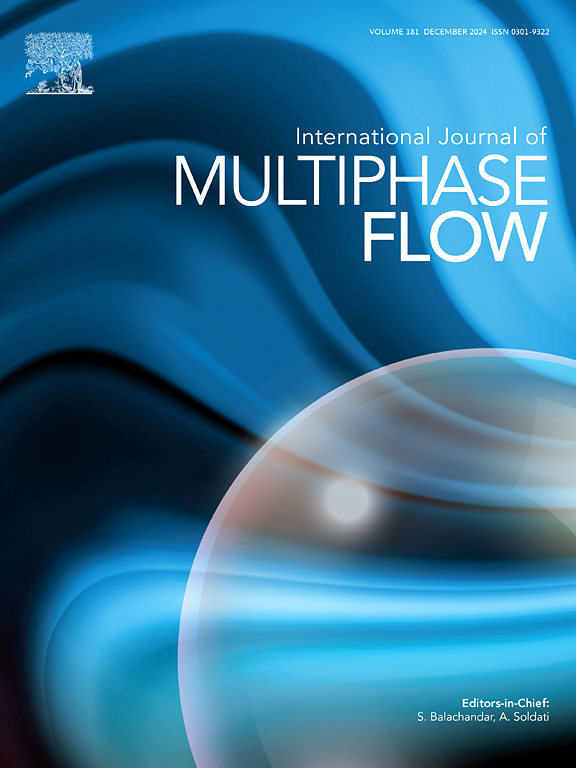Vapor condensation heat transfer on mixed-wettability surface with lattice Boltzmann model
IF 3.6
2区 工程技术
Q1 MECHANICS
International Journal of Multiphase Flow
Pub Date : 2025-04-12
DOI:10.1016/j.ijmultiphaseflow.2025.105259
引用次数: 0
Abstract
Based on an improved three-dimensional phase-change lattice Boltzmann method (LBM), this study conducts three-dimensional numerical simulations for vapor condensation heat transfer on the mixed wettability surface consisting of a hydrophobic substrate decorated by the hydrophilic regions. Droplet nucleation, growth and detachment from such surface are discussed in detail, with regarding the parametric effects of the shape, size and spacing of the hydrophilic regions, as well as contact angles of both the hydrophilic and hydrophobic regions. Results show that the hydrophilic regions with identical area but different shapes lead to minor differences in heat transfer performance. However, the regions with equal perimeter but various shapes can result in significant differences. The size of the hydrophilic region is a key factor affecting droplet nucleation, and a larger hydrophilic region can increase the surface heat flux and enable earlier droplet detachment. Besides, a smaller spacing between hydrophilic regions promotes droplet formation, despite the fact that an excessively small spacing inhibits droplet detachment. The contact angles of both hydrophilic and hydrophobic regions can affect droplet formation, with the former influencing early-stage formation and the latter impacting later-stage growth. This study further improves the understanding of the mixed wettability surfaces used in the vapor condensation scenario from the numerical view.

基于晶格玻尔兹曼模型的混合润湿性表面的蒸汽冷凝传热
基于改进的三维相变晶格玻尔兹曼方法(LBM),对由亲水区域装饰的疏水衬底组成的混合润湿性表面上的蒸汽冷凝传热进行了三维数值模拟。详细讨论了液滴的成核、生长和脱离,并讨论了亲水区域的形状、大小和间距以及亲水和疏水区域的接触角的参数影响。结果表明,面积相同但形状不同的亲水区域对换热性能的影响较小。然而,相同周长但形状不同的区域会导致显著差异。亲水区域的大小是影响液滴成核的关键因素,较大的亲水区域可以增加液滴的表面热通量,使液滴更早脱离。此外,亲水性区域之间较小的间距促进了液滴的形成,尽管过小的间距会抑制液滴脱离。亲水区和疏水区的接触角都能影响液滴的形成,亲水区影响液滴早期形成,疏水区影响液滴后期生长。本研究从数值角度进一步提高了对蒸汽凝结场景中使用的混合润湿性表面的理解。
本文章由计算机程序翻译,如有差异,请以英文原文为准。
求助全文
约1分钟内获得全文
求助全文
来源期刊
CiteScore
7.30
自引率
10.50%
发文量
244
审稿时长
4 months
期刊介绍:
The International Journal of Multiphase Flow publishes analytical, numerical and experimental articles of lasting interest. The scope of the journal includes all aspects of mass, momentum and energy exchange phenomena among different phases such as occur in disperse flows, gas–liquid and liquid–liquid flows, flows in porous media, boiling, granular flows and others.
The journal publishes full papers, brief communications and conference announcements.

 求助内容:
求助内容: 应助结果提醒方式:
应助结果提醒方式:


